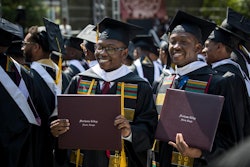Yale Conference Examines Life, Work of Michael Jackson
NEW HAVEN, Conn.
Michael Jackson, frequently savaged in the tabloid press, was picked apart by more rarified critics as scholars gathered for a conference on the pop star at Yale University.
Eighteen scholars from U.S. universities discussed sexual, racial and artistic aspects of Jackson’s life and music in late September, in the first academic meeting to study him.
Jackson “in many ways is the Black male crossover artist of the 20th century,” said Dr. Seth Clark Silberman, who teaches about race and gender at Yale. “He has grown up in front of us, so we have a great investment in him, even though some people today may find his image disturbing.”
Other universities have hosted conferences about Madonna and other pop stars, Silberman said.
The conference avoided details of the child molestation case against Jackson in California, but it did look at how the media has reported on the case. Jackson pleaded not guilty in April to child molestation and conspiracy charges. His trial is scheduled for Jan. 31, 2005.
Still, panelists discussed how pedophilia allegations have fed into false stereotypes about gays. Although Jackson married twice and has children, he has long battled rumors that he is gay, said Silberman, who is writing a book about Jackson.
Since his days as a child star, Jackson has made his image increasingly strange and contrary to sexual and racial expectations, Silberman said. Panelists discussed Jackson’s plastic surgery and his skin tone change from dark to light, which Jackson says is due to a condition called vitiligo.
Todd Gray, who was Jackson’s personal photographer for four years, described how Jackson asked him to retouch photos to make him appear lighter-skinned.
Record executives wanted Jackson to appear masculine in photos, while Jackson preferred pictures of himself kissing animals or hugging the Mickey Mouse mascot at Disneyland, Gray said.
Jackson often explores racial issues in his music, noted another panelist, Nora Morrison, a graduate student from Harvard University. In the video for “Beat It,” she said, Jackson breaks up a fight between a Black gang and a White gang, whose members then join in his dance moves.
Megan Burns, who is pursing a master’s degree in fine art, said she looks at Jackson as “a self-created piece of art.”
“He’s contributed to the national discussion of race and gender, and that is an invaluable topic for all of us to discuss,” she said.
— Associated Press
© Copyright 2005 by DiverseEducation.com


















